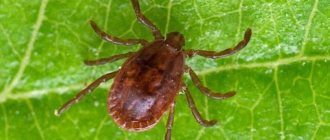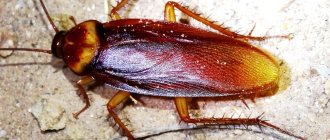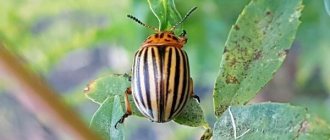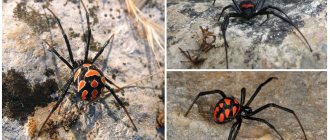With the onset of spring across the entire vast territory of Russia, along with the joy of blossoming buds and the first snowdrops, a familiar problem appears - the ixodid tick (lat. Ixodidae). The common people have the frightening name “encephalitis”, i.e. ticks that carry encephalitis. A more correct name for several types of ticks that bother people and animals is the dog tick or forest tick. The pasture tick also belongs to this category. Ticks appear in the spring, when the snow cover has not yet completely melted, and go into hibernation in late autumn with the onset of frost. But this does not mean that they are active throughout the warm season. To understand periods of tick activity, you should turn to biology.
Types of ixodid ticks
Ticks belong to the order Arthropods, not insects. Closest relatives are crabs. A distinctive feature is the presence of four pairs of legs, not three. This family of arthropods includes more than 650 species distributed throughout the world.
Ixodid ticks are found even in the Arctic and Antarctic, parasitizing penguins and Arctic birds. Some species are carriers of dangerous infections - encephalitis, borreliosis and a whole bunch of other, no less dangerous, infections. The most dangerous types of ixodid ticks in terms of their distribution are:
- Forest or taiga tick – Ixodes persiucatus
- Dog tick – Ixodes ricinus
- Meadow or pasture tick – Dermacentor reticulatus.
The latter does not belong to ixodid ticks, but to a different subtype, but recently its spread, as well as the similar biology and the danger of the infections it carries, has caused serious concern among specialists. All these types of mites are parasitomorphic.
Maliciousness
Ixodid ticks feed exclusively on blood and can parasitize humans, as well as both wild and domestic animals. The danger from contact with them is that they are capable of carrying many pathogens of quite serious diseases. On a note! During a bite, an infected ixodid tick, along with salivary secretions, transmits the virus to its owner, which certainly enters the blood!
Danger to humans
On the territory of the Russian Federation, there are two species of ixodid ticks, which are carriers of tick-borne encephalitis and Lyme disease. In this case, the danger comes from ticks of the genus Ixodes: Ricinus (dog) and Persulcatus (taiga).
Also, the ixodid tick can provoke the development of diseases such as:
- Relapsing fever.
- Typhus.
- Tularemia.
- Paroxysmal rickettsiosis.
- Hemorrhagic fever.
- Marseille fever.
- Q fever.
In this case, the virus is able to penetrate the body even when an infected tick is crushed.
For this reason, attempting to kill an adult with bare hands is highly discouraged. But here you should know that an ixodid tick bite will not always result in a disease. People with high levels of interferon and those who have been vaccinated are excluded from the risk group.
Danger to animals
In dogs, ixodid ticks can provoke the development of such serious diseases as piroplasmosis, helminthiasis, as well as various bacterial infections. The situation is aggravated by the fact that the dog itself does not feel the bite, and therefore it is not possible to correct the situation immediately before it gets worse.
The only symptom may be an allergic reaction. If the animal does not have such a tendency, then, most likely, the bloodsucker will remain unnoticed. And the further it goes into the skin, the larger its size becomes and the more rapidly the risk of infection increases.
Ixodid ticks are also not uncommon in cats and, unfortunately, can cause considerable harm to their health.
And if the dog does not feel the bite of the parasite and does not react to it in any way, then the cat, on the contrary, begins to actively itch. This is due to the fact that the secretion secreted by the bloodsucker provokes itching in the animal. And in this case, it is scratching that is dangerous, since in the process the cat can simply tear off the body of the tick, leaving its head in the skin. And this is fraught with the development of suppuration, sometimes sepsis.
Life cycle and lifestyle of the ixodid tick
The biology of tick reproduction and nutrition determines when they are more active and dangerous to humans. There are three stages of development - larva, nymph and imago (mature individual). The female is twice as large as the male and the shield on her back covers 2/3 of the body. The female, filled with blood, swells to a gray pea with a diameter of up to 11 mm.
Based on the existing analogy with blood-sucking insects, in particular mosquitoes, many believe that only the female feeds on the blood of animals; this is not entirely true. Ixodid ticks feed once for each stage. It can be not only warm-blooded animals or humans; the tick parasitizes both amphibians and birds. They move quickly, but choose the suction site carefully, from an hour to two. The female, having drunk blood, mates and then moves to the soil, laying eggs on the stems of plants. She can lay up to 3000 eggs.
The hatched larvae climb onto bushes and tall grass and wait for the victim with their front legs with hooks extended forward. In appearance, the tick larva is similar to the adult, but has a dull dark color. The larva needs nutrition for development.
After sucking on the animal’s blood, the larva hides in the forest floor, moults and turns into a “nymph.” This is an analogy to the pupa in insects, with the only difference being that the nymph is active and also requires nutrition. Full development occurs in 1-1.5 years, but can take up to 4 years. The period of starvation for larvae, nymphs and adult ticks can last up to a year.
Lifestyle and habitats
Ixodid ticks are mainly pasture parasites that wait for their hosts in open nature. To live, they prefer mixed forests and clearings with high grass cover. The process of their “hunting” is usually passive - ticks almost never intentionally pursue potential victims, they simply wait for the right moment to latch onto fur or clothing.
Ixodid ticks are generally very slow - each individual travels no more than a couple of tens of meters in its entire life.
At each stage of development, the parasite needs to feed only once, therefore, having had enough on the host, it disappears, and only in some cases can it remain on the host’s body to move to the next instar. Ticks overwinter mainly in the forest floor, sometimes in the burrows of their owners or even on them.
Species that have adapted to specific burrow parasitism often cope much easier with the search for food - after all, blood sources are nearby almost all the time. An example is the tick Ixodes laguri, which lives in rodent burrows.
This is interesting
In certain cases, strict specificity in the choice of prey greatly limits the rhythm of life of the tick itself. For example, Ixodes uriae, which has adapted to living in rock cracks in bird colonies, can feed only during bird nesting, and starves the rest of the year. Due to the peculiarities of the geography of its habitat, this species even parasitizes penguins.
It is also useful to read: How forest ticks reproduce
Climatic and time preferences of ticks
As already noted, these arthropods are common in all climatic zones of the Earth, are very tolerant of temperature changes and can be in a state of starvation for a long time. But favorable conditions for reproduction determine the period of tick activity. When the air temperature rises in certain hours from 10°C, when the forest floor is heated by the sun, forest ticks emerge from hibernation.
The end of March - the beginning of April is the time when these arthropods can already be found, but night frosts and periodic cold precipitation restrain their activity. Having moved onto the body of a warm-blooded animal, the tick feels comfortable and makes an attempt to suction. Already during this period, a person should take safety measures against bites of ixodid and pasture ticks.
In which months are ixodid ticks most active?
The period of tick activity by month looks like a double sine wave - a rise from April, a peak at the end of May, then a decline and a new rise in September. As explained above, spring is the time when tick larvae and nymphs emerge from the litter to feed, as well as the breeding season of adults, which is why late spring and early summer are the most dangerous times.
See the article “Tick Season”.
The autumn peak occurs when the larvae emerge from the eggs, which occurs after 10 weeks. Taking into account the time for development and laying of eggs, the second peak occurs at the end of summer - beginning of autumn. Moreover, fall activity is higher in the European part of Russia. Siberia, with its sharp cooling, experiences this peak less acutely.
Reproduction and development
It is not easy to give a general characteristic for all ixodids in terms of reproduction and development. They are characterized by a huge variety of life cycles in terms of total duration and seasonal activity of hungry individuals. All three active stages can develop in one warm season, sometimes even several generations are formed during this time. In other cases, the transition from egg to larva, nymph, and then adult requires quite a lot of time, and the cycle stretches for up to five years.
It is also useful to read: Parasitic ticks: interesting facts
The total duration of blood sucking on the host during the entire life of an ixodid tick reaches a total of about 15 days, which is an extremely small fraction of the total duration of ontogenesis. But during this time, serious qualitative changes occur in the tick’s body, associated not only with the stretching of the body’s integument during feeding, but also with the development of its body as a whole. Thanks to this, after saturation, the larva becomes a nymph, and that, in turn, becomes an adult.
As already mentioned, at different stages of development, ticks attack animals of different sizes. If in the first two stages the victims of most ixodids are small rodents, reptiles and birds, then adults already prefer large animals, including ungulates and humans.
Depending on how many hosts a tick changes during its life, the types of parasitism and the proportion of surviving individuals differ. Three-host ticks survive worse than two- and one-host ticks, because they are forced to leave the previous victim after each act of feeding, and finding the next one is often very difficult. Therefore, at the stage of larvae and nymphs, such ixodids die en masse. Although this does not apply to nesting and burrow parasites, which actually share a home with their owners, and are more likely to be provided with food.
The reproduction of ixodid ticks is also not without interesting details. The search for a partner and the mating itself most often takes place directly on the owner. This is explained by the fact that searching for each other in nature is extremely difficult due to their solitary lifestyle, wide habitat and low mobility.
In addition, individuals of some species are generally incapable of mating without being engorged with blood. Therefore, the ideal place for a “date” is just at mealtime. On the 3-5th day of blood sucking, adult female ixodids begin to secrete special compounds - pheromones, which attract males.
Mating takes place directly while the female is feeding, which she does not interrupt for several days after insemination. The male either dies immediately after mating, or he can consume another portion of blood and go looking for a new female.
By the way, the nutrition of ticks differs depending on gender. In general, all ixodids are characterized by much shorter suction of males to the owner compared to females - they only need a couple of hours to get enough. And the body of males itself is not adapted for large volumes of blood - it is surrounded on all sides by rigid, inextensible shields.
After the fertilized female is saturated with a sufficient amount of blood, she falls away from the owner and prepares for the process of laying eggs. Their maturation takes from several days to a month, and occurs thanks to nutrients obtained from the blood of the last victim.
The oviposition process itself is also long - from three weeks to two months. At the same time, a female dog tick will lay an average of 2000-3000 thousand eggs, but individuals of more exotic tropical species will lay up to 20 thousand eggs, and sometimes even 30 thousand or more.
In what weather are ticks most active?
An additional condition conducive to tick activity is the weather. In what weather are ticks most active? They love warm, humid weather , wet, rainy summers, and long, cloudy springs—the most favorable time for ticks to reproduce. For example, spring came early in 2021 and ticks in the Moscow region became active ahead of time.
By planning your visits to places where there is a risk of encountering a tick, you can reduce the risks to a minimum. Schedule a time when ticks are no longer active. When the clear midday sun reduces activity, ticks hide until the evening. High temperatures and dry air inhibit ticks, but are most comfortable for outdoor recreation.
How to protect yourself from ixodid ticks?
Having gained an understanding of what ixodid ticks are, what their way of life and reproduction is, we can protect ourselves as much as possible from the unpleasant moments of suction and, in addition, receiving a dangerous infection. You should remember basic safety measures when you are in the forest and field in the summer:
- Try not to plan a picnic or outdoor recreation during peak periods of tick activity.
- Use repellents and clothing that is good at preventing ticks from crawling underneath.
- When stopping, sit in sunny and dry areas of the area, where you are less likely to encounter ticks.
- Conduct self-examination and mutual inspection every 2 hours in the forest.
The most effective measure against infection by infections carried by ixodid ticks is preventive vaccination with an encephalitis vaccine, which is carried out a month before the time of tick activity. In the absence of vaccination, urgent vaccination with immunoglobulin is an effective measure of protection.
What diseases do Ixodid ticks carry?
We wouldn't be so afraid of ticks if their bites were safe. But, unfortunately, ticks carry several diseases that can ruin a person’s life and health. The main diseases transmitted by ixodid ticks are listed below.
Tick-borne encephalitis
Tick-borne encephalitis is the most common disease that a tick can infect a person with. Encephalitis ticks are most common in taiga and forest zones. Every year in Russia about 500 thousand people, of which about 2000 become infected with encephalitis. Encephalitis is a focal infection that damages the central nervous system and can lead to paralysis of the limbs and other serious diseases. If you are bitten by a tick, remove it, store it in a container, and take it to a laboratory to determine whether it was contagious. If the answer is yes, start treatment immediately!
Tick-borne borreliosis, Lyme disease
Borreliosis is another dangerous tick-borne disease, also called Lyme disease. Bacteria that enter the human blood spread throughout the body and cause inflammation of internal organs, which can lead to their damage. If treatment is not started in time, the consequences can be disastrous: disruption of the cardiovascular system, organ damage, Lyme arthritis, and in the most severe cases, death.
Borreliosis infection from a tick bite can be identified by a light spot that forms around the bite, followed by a red circle. If you see such a mark after a bite, immediately consult a doctor and start treatment!
Methods of protection against ticks
A picnic, gardening, and even a regular walk in a city park can be marred by ixodid ticks. Timely protective measures will protect you from these harmful arthropods. Ticks are especially active from mid-spring to late autumn.
The bite of the forest ixodid tick is unpleasant in itself - it can cause inflammation and an allergic reaction.
But in addition to this, ticks are capable of transmitting tick-borne viral encephalitis (TBE), tick-borne borreliosis (Lyme disease) and a number of other serious diseases. Tick-borne Lyme Borreliosis is an infectious disease with a rather insidious nature, since its symptoms resemble ARVI: cough, runny nose, headache, weakness.
Symptoms of a viral infection can last up to three months. The bite site takes on the appearance of a spot with bright edges. Tick-borne encephalitis (TBE) of the spring-summer type is a viral infection that affects the central and peripheral nervous system.
The first symptoms after a bite appear after two weeks (the incubation period lasts on average from 1 to 30 days). The disease develops acutely and can result in paralysis and death. Tick-borne encephalitis has long crossed the borders of Siberia, and now 70% of the territory of Russia is considered a hotbed of this disease.
Ticks, unlike insects, have four pairs of legs (insects have three pairs).
These are bloodsuckers, parasites of mammals and birds. Humans are usually attacked by adult, hungry females. Their body is flattened, brick-red or brown, with a dark or ornamented shield.
Ixodid ticks are widespread in mixed forests, but now you can meet them in garden plots, holiday villages, green areas of cities, parks and squares. There are especially many of them on forest edges, in thickets along the banks of streams, on the sides of forest roads and paths.
Ticks spend most of their lives in the loose forest floor, emerging from there to search for prey.
They are active in the morning and evening hours. Ticks climb herbaceous plants to a height of up to one and a half meters, where they lie in wait for prey, putting their first pair of legs forward. They cling to passing animals or people, but do not crawl into trees or fall from above. The parasite's bite is painless, although the proboscis penetrates deep into the skin.
How to protect yourself from ticks
Blood-sucking ixodid ticks carry 3 viral, 22 bacterial and several protozoal infections that can infect humans. Can we eradicate such diseases, just as we eradicated smallpox? The answer is no.
The causative agents of all these infectious diseases exist in nature independently of humans, and vectors are an integral part of natural ecosystems. Wild animals can be “reservoirs” and carriers of pathogens of a number of infectious diseases that are dangerous to humans.
Among them are viruses (for example, the arbovirus that causes West Nile fever), bacteria (for example, Borrelia), tapeworms and flatworms (for example, alveolar echinococcus and opisthorchid), etc.
For all these infectious agents, humans are an accidental host, a hopeless “biological dead end.” Infection of people can occur in different ways (with milk or meat of an animal, through a bite, water, air, dust), but almost never directly from person to person.
The carrier animals themselves can also become ill, but their disease usually occurs in a milder form. This is a “bonus” for the long co-evolution of the host and the parasite, which does not benefit from causing too much harm to its victim.
We owe the doctrine of the natural focality of infectious diseases to the outstanding Russian parasitologist E.N. Pavlovsky, who developed it back in the 1930s. Among all natural focal diseases, vector-borne diseases, transmitted through blood-sucking carriers, stand out: according to WHO data, they today account for 17% of all cases of infectious diseases in the world. In our country, the greatest danger is posed by ixodid ticks, which transmit diseases dangerous to humans such as tick-borne encephalitis and tick-borne borreliosis (Lyme disease).
The development cycle of the taiga tick, which can be found in the forest and even in a city park, has three stages, and each of them is preceded by a “blood meal”.
One-year-old larvae feed on small forest rodents, two-year-old nymphs supplement their diet with the blood of birds collecting food on the ground. An adult tick is capable of attacking large forest inhabitants - hares, ungulates and predators.
And at each stage of life, the tick can either receive the infectious agent itself along with the blood, or, conversely, infect the “host” through the secretion of its salivary glands. Humans and pets, as a rule, become accidental prey for ticks.
The likelihood of transmitting an infection through a bite depends on the degree of infection of the tick itself (not all ticks are carriers of infectious agents). In the case of encephalitis, the risk of getting sick is largely determined by the level of virulence (ability to cause disease) of the virus itself.
Both of these indicators - infection and virulence - can vary significantly from year to year.
In principle, the probability of getting sick after a tick bite is low: for example, in one week in May 2021, about 1.5 thousand people were bitten by ticks in the Novosibirsk region, while the encephalitis virus was found in only 4 tick individuals, and the causative agents of borreliosis - at 135.
You just need to remember that today it is impossible to determine whether a tick is infected with absolute accuracy, so you should carefully monitor your health and, if necessary, get tested for specific antibodies.
In conclusion, we add that the level of disease in people in natural infectious foci is largely determined by the frequency of contact of the population with its potentially dangerous inhabitants. And also ways to solve this problem: from environmentally dangerous total treatment with pesticides to total vaccination of risk groups, as is done in Western countries in relation to tick-borne encephalitis.
In any case, natural foci of infectious and invasive diseases exist and will exist as long as the natural ecosystems of which they are an integral part are preserved.
What to do to protect yourself:
- Before traveling to an area with an increased risk of contracting tick-borne encephalitis, you should get a preventive vaccination; it can be given at a local clinic, medical center or vaccination point. You need to take care of the vaccination in advance, at least 21 days before the trip (with an emergency vaccination schedule).
- When going into the forest, you need to dress so that ticks cannot get under your clothes. It is better to tuck a shirt with a buttoned collar and long sleeves with an elastic band or tight-fitting cuffs into trousers, and tuck your hair under a scarf or hood. Tuck trousers into boots or socks with thick elastic. Special protective anti-tick overalls are also perfect for walking.
- Wear light-colored clothing when going to the forest—it’s easier to spot ticks on light-colored fabric.
- Treat clothing with special acaricidal and repellent agents that kill or repel arthropods.
- Check your clothes every half hour. It is advisable to destroy any detected ticks. It is better not to sit or lie on the grass, but to camp and spend the night in the forest in areas without grass vegetation.
- When you return home, inspect your clothes again (store the things you wear in the forest in a non-residential area).
- Ticks usually choose areas with delicate, thin skin: the neck, armpits, groin area, ears, scalp.
- Examine pets before allowing them into your home.
- Be careful: ticks can be brought into the house with forest flowers, mushrooms, and berries.
- The incubation period of tick-borne encephalitis lasts up to 30 days (on average 7–14). If you are bitten by a tick, pay attention to your well-being during this period.
What to do after a tick bite
It is better to remove the tick in an emergency room, clinic, or other medical care facility. To remove a tick yourself, you can use a curved mosquito-type surgical clamp, an anti-tick loop, or curved tweezers.
If you have nothing at hand other than regular tweezers, then this will do. The tick must be grasped with tweezers as close as possible to the base of the penetration of the trunk. Gently, without pressing, grab the tick and make several full turns (2-3).
Disinfect the bite site (70% alcohol, 5% iodine). After removing the tick, wash your hands thoroughly with soap.
If the head or proboscis of the tick is torn off, a black dot remains on the skin, which must be treated with 5% iodine. The tick should not be thrown away unless the risk of contracting tick-borne infections is excluded. Tick examination is desirable, but not necessary.
Prevention of encephalitis should be carried out without waiting for the results of a tick test. The presence of a pathogen in a tick does not mean that the bitten person will develop encephalitis or borreliosis, and a negative result does not always guarantee that the disease will not develop.
If the bite did not occur in the Far East, not in Siberia, but at a dacha or in the Moscow region, most likely the bite will not affect your well-being. If you are bitten in a high-risk area, place the removed tick in a small glass bottle with a tight lid and place a slightly damp piece of cotton wool or paper napkin in it.
In a closed bottle, it can be stored in the refrigerator until it is possible to deliver it to the laboratory for analysis (preferably within 2 days).
After removing the tick, it is necessary to monitor your well-being, and if symptoms appear that may be a manifestation of a tick-borne infection, you should consult a doctor. Always first contact an ambulance for an initial consultation by calling 03, or from mobile phones - 112.
Depending on your health and clinical picture, you will either receive a call from a team or be transferred to a doctor for a telephone consultation. In the ambulance, do not forget to find out where in your area you can get an emergency injection of anti-encephalitis immunoglobulin.
Anti-tick immunoglobulin is a domestic drug that contains ready-made antibodies to the tick-borne encephalitis virus. There is also one imported drug - FSME-Bulin (FSME-Bulin, Immuno AG, Austria). If you have fever, weakness, headache, muscle or joint pain, inflammation or redness around the bite site, consult a doctor immediately.
A blood test should be taken to determine the presence of the disease. You can be tested for tick-borne encephalitis no earlier than 14 days from the date of the tick bite, and for borreliosis after three weeks.
What to do after a tick bite, advises a leading researcher at the Laboratory of Disinfestation Problems at the Federal State Institution Research Institute of Disinfectology:
Emergency prevention of tick-borne encephalitis
Do not self-medicate. The decision to administer drugs can only be made by a doctor. Another thing is that the necessary medicine may not be available. Emergency prevention of tick-borne encephalitis is carried out using antiviral drugs or immunoglobulin.
If you are going on a trip through a forest area, buy the drugs Yodantipirin and Immunoglobulin in advance. It is used for emergency prevention of tick-borne encephalitis in adults and children over 14 years of age). The drug destroys the tick-borne encephalitis virus within a few days from the moment of infection through an ixodid tick bite. Start taking it on the first day. Yodantipyrine is not a substitute for vaccination!
Adults are given free of charge when visiting a special point. They do not protect against tick-borne borreliosis and other infections.
Remantadine can also help if you start taking it immediately (no later than 2 days from the moment of the bite). This drug is usually used to prevent influenza. But it also has little antiviral activity against the tick-borne encephalitis virus.
In the event of a tick bite in children, for the purpose of emergency prevention of tick-borne encephalitis, it is recommended to use Anaferon for children in doses: at the age of up to 12 years, 1 tablet 3 times a day, at the age of over 12 years, 2 tablets 3 times a day for 21 days (incubation period of tick-borne encephalitis). encephalitis), which prevents the development of the disease.
There is no vaccine against tick-borne Lyme Borreliosis yet.
Doxycycline, Amoxicillin and other tetracyclines are used to prevent and treat Lyme disease. To prevent borreliosis, a course of antibiotics may be prescribed. But the decision about the need for such prevention can only be made by a doctor.











